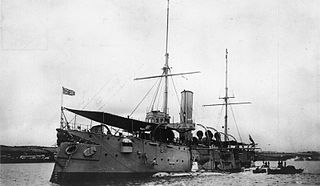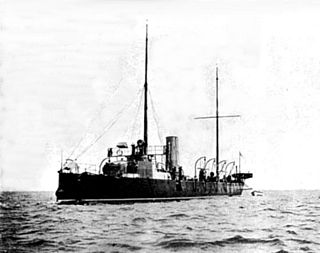
HMS Pelorus was an Algerine-class minesweeper built for the Royal Navy (RN) during World War II. Upon completion, the ship became the flotilla leader of the 7th Minesweeper Flotilla, clearing mines off the east coast of England. In June 1944, the flotilla was assigned to sweep one of the beaches during the Normandy landings until she struck a mine the following month. After her repairs were completed, Pelorus was reassigned to the English Channel and the 6th Minesweeping Flotilla. The flotilla was transferred to the Indian Ocean in 1945 and spent some time escorting convoys. They participated in Operation Collie, a bombardment of Japanese positions in the Nicobar Islands, in July and then swept the Strait of Malacca and the approaches to Singapore in August.

HMS Thames was a Mersey-class protected cruiser built for the Royal Navy (RN) in the 1880s. The ship was placed in reserve upon her completion in 1888 and was converted into a submarine depot ship in 1903. She was sold out of the navy in 1920 and was purchased by a South African businessman to serve as a training ship for naval cadets under the name SATS General Botha. The ship arrived in South Africa in 1921 and began training her first class of cadets in Simon's Town the following year. General Botha continued to train cadets for the first several years of World War II, but the RN took over the ship in 1942 for use as an accommodation ship under her original name. She was scuttled by gunfire in 1947 and is now a diveable wreck.

HMS Wessex was one of eight W-class destroyers built for the Royal Navy during World War II. Completed in 1944, the ship spent most of the war assigned to the Eastern and Pacific Fleets. She screened British aircraft carriers as their aircraft attacked targets in the Japanese-occupied Nicobar Islands, the Dutch East Indies and Okinawa.
Five ships of the Royal Navy have borne the name HMS Flora:
Six ships of the Royal Navy have borne the name HMS Griper:
Four ships of the Royal Navy have borne the name HMS Gadfly:

HMS Rattlesnake was a unique design of torpedo gunboat of the Royal Navy. A result of the Russian war scare of 1885, she was designed by Nathaniel Barnaby that year and built by Laird Brothers, of Birkenhead. Quickly made obsolete by the new torpedo boat destroyers, she became an experimental submarine target ship in 1906, and was sold in 1910.

SAS Somerset was a Bar-class boom defence vessel of the South African Navy, now preserved as a museum ship in Cape Town. Formerly HMS Barcross, it operated in Saldanha Bay, transferred to South Africa Naval Forces during World War II and was purchased by South Africa in 1947.

HMS Ascension (K502) was a Colony-class frigate of the United Kingdom that served in the Royal Navy during World War II. She originally was ordered by the United States Navy as the Tacoma-class frigateUSS Hargood (PF-74) and was transferred to the Royal Navy prior to completion.

SAS Good Hope was one of three Loch-class frigates in the South African Navy (SAN). It was built as HMS Loch Boisdale (K432) for the Royal Navy during World War II, but was transferred to the SAN before completion in 1944 and renamed as HMSAS Good Hope. The ship was assigned to convoy escort duties in 1945, but did not encounter any enemy ships before the end of the war.

HMSAS Protea was a survey ship of the South African Navy. The ship was originally built as a Flower-class corvette for the Royal Navy during World War II named Rockrose and was sold to South Africa after the war. Rockrose was initially assigned to convoy escort duties in the North Atlantic after her completion in 1941, but was later transferred to South African waters and then to the Far East with the same mission. She returned home in 1945 and was paid off.
Several vessels of the British Royal Navy have been named Tickler:

HMSAS Natal was one of three Loch-class frigates in the South African Navy (SAN). It was built as HMS Loch Cree (K430) for the Royal Navy during World War II, but was transferred to the SAN before completion in 1945 and renamed as HMSAS Natal. Just hours after finishing fitting out, the ship sank a German submarine off the coast of Scotland in early 1945. It was assigned convoy escort duties for the remaining few months of the war in Europe. Natal had her anti-aircraft armament reinforced for service in the Far East after arriving in South Africa in June. In September–October, the ship participated in the reoccupation of British Malaya before returning home the following month.

SAS Transvaal was one of three Loch-class frigates in the South African Navy (SAN). She was built as HMS Loch Ard (K602) for the Royal Navy during World War II, but was transferred to the SAN in 1944 before completion and renamed as HMSAS Transvaal. The ship was completed shortly after the German surrender in May 1945 and did not participate in the war.
HMSAS Bloemfontein was an Algerine-class minesweeper built for the Royal Navy in Canada during World War II. The ship was originally named Rosamund and spent several years clearing minefields in Europe after she was completed in 1945 before she was placed in reserve. Rosamund was purchased by South Africa in 1947 and later renamed HMSAS Bloemfontein.

HMS Teviot (K222) was a River-class frigate of the Royal Navy (RN) from 1942–1955. She served in convoy defence duties in the North Atlantic and Eastern Fleet during World War II. After the war, she served in the South African Navy as HMSAS Teviot before returning to Royal Navy service after six months. Teviot was built to the RN's specifications as a Group I River-class frigate.

SAS Skilpad was a mine-layer vessel of the South African Navy during and after the Second World War. She was launched as the German trawler Polaris and after being captured by the Allies in 1940, she was commissioned into the Royal Navy as a war-prize and named HMS Spindrift. During the course of the war she was transferred to the South African Naval Forces, being based in Saldanha Bay and later in Durban. After being kept in storage in Durban for ten years after the end of the war, she sank at her moorings in Durban during a gale in 1952, leading to her being decommissioned and sold for scrap in 1957.

HMSAS Protea was the first hydrographic survey ship used by the South African Naval Service. The ship was laid down as a minesweeper to be named HMS Ventnor in 1917 but was renamed HMS Verwood in 1918 before she was launched. She was again re-named and launched as HMS Crozier on 1 July 1919. The vessel was converted from a minesweeper to a hydropraphic survey vessel in 1921 and transferred to the South African forces in 1922, where she was commissioned as HMSAS Protea. She served as a survey vessel until 1933 when she was returned to the Royal Navy. Protea was eventually sold by the Royal Navy and renamed MV Queen of the Bay where she went on to operate as a pleasure craft out of Blackpool. She was subsequntly sold to the Spanish Navy and renamed Lieutenant Captain Remigio Verdia, and used as supply vessel to run blockades, smuggling supplies to the anti-fascists in Spain during the civil war. She ran aground and sunk off Cartagena in Spain in 1939.













